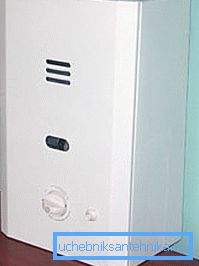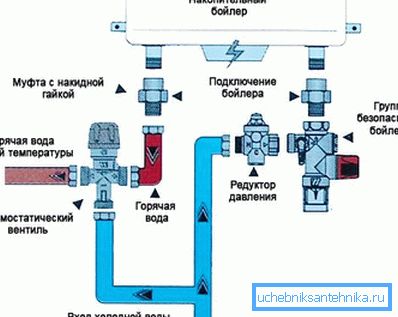How to connect the water heater to the water supply - an
Hot water in the house is one of the components of a comfortable life. In the expanses of our great homeland, there is not everywhere a centralized hot water supply, so people install local heating systems. But the acquisition of such a device immediately gives rise to the next question, how to connect a water heater to the water supply system correctly. Everything that, one way or another, is connected with this, we will discuss further.

Important: similar units, depending on the method of heating are divided into 2 large directions. This gas equipment and electrical appliances. So self-installation of a gas heater, in the common people of the column is strictly prohibited. Therefore, in the following, we will consider only devices operating on electricity.

Types of equipment
The modern market is so heavily saturated with such units that it is sometimes difficult for an ordinary person to understand this abundance.
To avoid mistakes, because the price of such devices can be quite high, you need, first of all, to clearly define for what purpose you need a heater and how often you plan to use it.

Important: the scheme of connecting the water heater to the water supply in the apartment and in a private house is not much different. In particular, the units used are the same. The difference can only be in the number of related fittings.
- This equipment is flow-through and cumulative.. Flowing equipment, as the name implies, works only at the time when the fluid passes through the unit. Cold water comes, heats up in the heat exchanger and comes out already warmed up. The most popular here are geysers.

- Electrical appliances are also available that operate in a similar flow pattern.. They have compact dimensions and small volume, but a serious disadvantage here is the significant energy consumption and the need to install reinforced electrical wiring.
- Far more popular among electrical appliances are storage heaters, better known as boilers.. The principle of operation is simple, the heating elements are installed in the tank, and a significant volume of water is immediately heated, after which it is consumed as needed. The temperature in the boiler is constantly maintained by periodically turning on the same heating elements.

- The story would not be complete if we did not mention the devices of indirect heating. As a rule, they are installed in addition to the heating boiler. In fact, they are the same storage type boilers, only the water in them is heated not by electric heating elements, but by a coil or heat exchanger fed from a heating boiler.
- All similar equipment can be mounted and floor. The capacity of mounted boilers often does not exceed 100 - 150 liters, they can be mounted horizontally or vertically. Floor-mounted units, as a rule, have a large volume and a powerful, sometimes complex, heating system, although there are also compact models designed for installation under the sink.
Important: any installation instructions for horizontal or vertical heaters strictly prohibit changing the direction of installation. In other words, horizontal devices can not be installed vertically, and vertical horizontally.

General principles of installation
Before you buy a unit, decide where you will put it. Measure how much free space you have. The fact is that boilers are recommended to be installed as close as possible to the place of operation.
If this is a kitchen, it is better to mount it, either above the sink or under the sink. The same principle applies to the bathroom. The farther the tank will stand from the crane, the greater will be the heat loss during transportation. It is also immediately better to consider the convenience of connecting to a cold highway and the power grid.
Tip: a water heater without a water connection can be mounted, but for this you will need to provide the unit with an alternative water supply. Under cottage conditions, this may be an improvised water tower with a height of 6–10 m. For year-round operation, it is better to purchase a pumping station.

Regardless of what type of appliance you have chosen, connecting the electric water heater to the water supply system begins with hanging it on the wall or setting the floor unit in a fixed stationary position. Horizontal boilers often have 2 attachment points, vertical 4.
Fixing the tank with your own hands is not difficult in principle, the main thing is not to be mistaken with the cross section of anchor bolts. Plus, such equipment is mounted only on powerful, bearing walls. Holes are drilled, dowels are installed and anchors are screwed in.
Installation of cumulative action system
The basic scheme of connecting the storage water heater to the water supply consists of several stages. First of all, decide which pipes you will connect.

Fixed rigid pipe made of metal or polypropylene is reliable, but without proper skills it is difficult to mount. We advise you to connect the water heater to the water supply system using flexible metal-plastic pipes or soft reinforced hoses. In the first case, you will additionally need crimp tube fittings. And in the second, only winding and keys.
Before connecting the storage water heater to the water supply system, a safety valve is mounted to the cold water inlet branch pipe on the tank. All reputable manufacturers initially complete their units with such a valve. But if the bundled one does not go, then it must be bought. Without such a valve, the boiler may simply explode.
Tip: in the water supply system of city apartments there are often significant pressure drops, which is dangerous enough for any boiler. Experts advise to immediately insert a special pressure reducer into the cold water supply line.

Both at the inlet and at the outlet ball valves are installed, with the help of which the adjustment of the boiler operation will be carried out. When the pipes are connected, you need to open both valves and fill the tank. A steady stream, without air plugs, from a pipe with hot water will signal about fullness. Then the boiler can be connected to the mains.
The scheme of connecting the electric water heater to the water supply includes another equally important stage. This connection of the unit to the mains. Immediately it should be noted that such equipment has great power and for it, you will need to install a separate power line. Otherwise, you run the risk of burning electrical wiring throughout the house or apartment.
Ideally, from the shield, a separate input is laid from a copper cable of suitable cross section and an input automat of the corresponding power is installed. To mount the socket or not depends on the room. It can be installed in the kitchen, and in the bathroom with its high humidity, the outlet will be superfluous.

Special attention should be paid to grounding; without it, you put your life at serious risk. In private houses, you can organize it yourself, scoring a few meters and a half metal pins into the ground. And in urban apartments there is grounding on the body of the switchboard in the stairwell or basement of the house.
Important: it is possible to connect any electric boiler only if it is completely filled with water. Otherwise, the appliance will simply burn.
| Unit power | Current calculation | Copper cross section |
| 1.0 kW | 4.5A | 1 mm? |
| 2.0 kW | 9.0A | 1.5 mm? |
| 2.5kW | 11.4A | 2.5 mm? |
| 3.0 kW | 13.6A | 2.5 mm? |
| 3.5kW | 15.9A | 2.5 mm? |
| 4.0 kW | 18.2A | 4 mm? |
| 4.5kW | 20.5A | 4 mm? |
| 5.0 kW | 22.5A | 4 mm? |
| 6.0kW | 27.3A | 4 mm? |
| 8.0kW | 36.4A | 6 mm? |
| 9.0kW | 40.5A | 10 mm? |
Table of recommended copper cable cross-section for connecting different units. For an aluminum conductor, the magnification factor will be 1.3 - 1.5.
Flow boiler connection
The connection scheme of the instantaneous water heater to the water supply is not much, but it is still different from the installation of its accumulative counterpart. First of all, the actions here are performed in a slightly different order. The first is mounted and connected wiring. As mentioned earlier, this equipment requires more powerful wiring.
Experts also recommend connecting the instantaneous water heater to the water supply system according to a special scheme. Its principle is similar to the installation of heating radiators with bypass. The heater cuts into the line and additionally mounted a pipe with a valve connecting the line cut by the heater, bypassing.

Thus, by blocking several valves, water can be started directly. As a result, it becomes possible to repair the unit without disconnecting the central water supply. As for pipes and fittings, they are used the same as in cumulative boilers.
The video in this article shows the connection options.
Conclusion
In conclusion, it should be noted that the flow-through version of the electric heater is advantageous to be installed only for short-term use in small volumes. If you need a lot of warm water, we advise you to give preference to aggregates of cumulative action.
